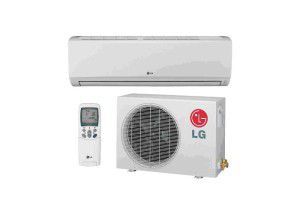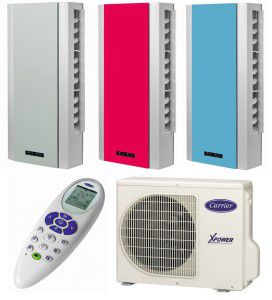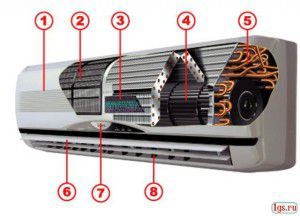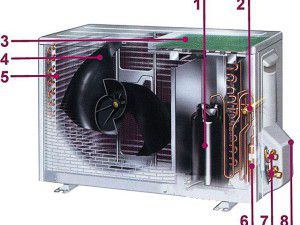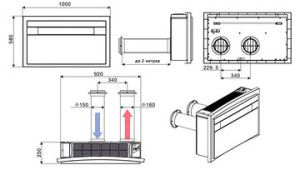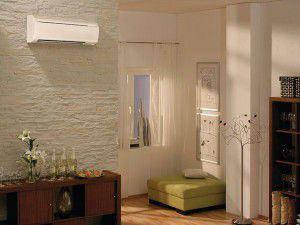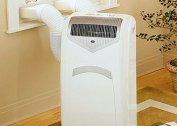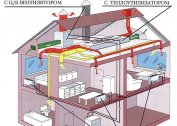The most popular air conditioners are considered stationary household wall models, since they are most often installed in apartments, private houses and small offices. They are:
- have a diverse and convenient functionality;
- perfectly cool, heat, ventilate and drain the air;
- cost relatively little;
- have a wide range of capacities specifically designed for rooms up to 35-40 m².
Although some manufacturers have wall-mounted home air conditioners with power that can cool up to 100 m², that is 10 kW. You should immediately determine the types of wall installations and their internal structure.
Types of wall conditioners
It is generally accepted that such devices are one of the types of split systems, which is a two-component installation. The composition includes two blocks: external and internal. The first is placed on the external wall of the building outside the window or attached to the balcony, if it is not possible to install on the facade. The second (room) module is mounted on a mounting plate on a wall in the room, taking into account the placement rules regarding the characteristics of a particular residential area.
The modules of a household wall-mounted air conditioner are interconnected by electrical communications and a freon route (pipeline) through which refrigerant circulates - a fluorine-containing hydrocarbon compound that changes its state during the vapor compression refrigeration cycle.
Progress does not stand still, so some manufacturers turned their attention to the production of non-standard split systems, namely, systems with a vertical wall unit, such as in inverter air conditioners CARRIER. Mount such a device in the corner of the room. Distribution of chilled or heated air goes along the walls, which eliminates the formation of zones with different temperatures.
But at the moment, many buildings fall under the existing ban on the deterioration of the external appearance of the architectural structure, so the outdoor unit is either hidden on the other side of the structure or purchased wall-mounted air conditioning without an external unit, that is, a monoblock unit in which all components are located in one housing.
Wall mounted air conditioner
As already mentioned, the split system and the monoblock air conditioning system are different in their structure. What a two-component wall air conditioner consists of is clearly visible in the picture:
- external protective panel.
- filter.
- deodorizing filter.
- fan.
- evaporator (heat exchanger).
- horizontal blinds.
- display.
- vertical blinds.
The panel can be easily removed if necessary to clean the filters or repair.
The first filter is usually responsible for rough cleaning. It retains large particles of dust, dirt, wool, pollen.
A deodorizing filter (most often carbon or electrostatic) removes odors and small particles of dust fragments. Not all household wall-mounted air conditioners are equipped with this element, but this fact does not bear any negative consequences for the operation of the device.
The fan is responsible for the circulation of air through the evaporator and its supply to the room.
In the heat exchanger, air heating / cooling takes place. Usually this unit is a copper tube and aluminum plate passing around the fan.
Through horizontal blinds, air is distributed in a horizontal plane. They can work in automatic mode or be fixed in the same position.
The LED display panel displays information on the current operating parameters (temperature, operating mode) and error codes (errors).
Vertical blinds distribute air vertically to the right and left. They can be controlled via the remote control or set the desired position manually.
The main working unit of the wall-mounted home air conditioner is located in the external unit, the composition of which is clearly visible in the following picture:
- compressor.
- four way valve.
- control board.
- fan.
- capacitor.
- Freon system filter.
- nipple connections.
- protective panel (removable).
The compressor of the outdoor unit is responsible for the circulation of freon in the refrigeration circuit, compressing the refrigerant under high pressure. This is the main working unit of the air conditioner. Its breakdown entails an expensive repair or replacement of the device with a new one.
The four-way valve is responsible for switching modes from cold to heat and vice versa.
The control board is an electronic control of all functions of the device.
In home air conditioners with a wall type of placement, with inverter control of the compressor, it is located in the outdoor unit, and for non-inverter in the room.
A fan usually has several rotational speeds. He is responsible for creating a stream of air blowing around the condenser.
In the condenser, freon is cooled and condensed.
The filter of the freon system protects the capacitor from foreign particles and inclusions during installation.
Interconnections - a freon route are connected to the nipple connections.
The protective side panel protects the choke joints from mechanical damage and the effects of weather.
Everything that wall split systems consist of is assembled in one device from monoblock air conditioners. But the presence of a compressor indoors does not make the work of a modern wall-mounted air conditioner without an external unit noisy. It is compact, quiet and has excellent performance, but this will be discussed further.
Technical characteristics and features of household wall air conditioners
There is no significant difference between split systems and monoblock wall-mounted air conditioners in their operation.
Both one-component and two-component plants have a wide range of operating temperatures for cold and heat. Most modern models are compact in size. In monoblocks, the thickness of the device is about 20 cm, which makes it indispensable in small rooms. The power consumption is small, so basically modern wall systems correspond to the energy class of group A. The use of 410 freon, which is environmentally friendly, allows us to call them environmentally friendly.
Of course, the two-component climate control system has lower noise characteristics than monoblock wall-mounted air conditioners, but the average sound level in the latter usually does not exceed 32-36 dB. This is significantly less than the noise characteristics of the same window or mobile air conditioners, if we compare the wall-mounted single-component devices.
The functional functional of both has no major differences. As well as split systems, wall-mounted air conditioners that do not have an external unit can work in cold / heat and drain or ventilate the air. They are controlled from the remote control or from the control panel located on the module itself.
A multi-stage filtration system, self-diagnosis with an audible signal, anti-icing, a timer, a comfortable sleep and other modes and functions - all this is in a single-component device.
As advantages, many monoblock wall-mounted air conditioners can be noted:
- supply and exhaust ventilation, which pre-purifies the air;
- a highly efficient heater, with which the device is functional at -15 ° C outdoors;
- a special condensate discharge system without laying a drain hose to the outside;
- unique scanning air diffuser (although modern splits are also equipped with it).
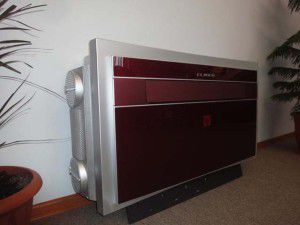
When installing, such an air conditioner is mounted on a mounting plate on a wall in which two ventilation holes are preliminarily made. The device is fixed in place with screws, and drilled holes are covered with special protective grilles. The entire installation takes a couple of hours.
A significant minus is the price of such an acquisition. It significantly exceeds the cost of a wall-mounted split system.
But the new two-component devices are not inferior to the perfection of monoblocks. As mentioned above, splits began to be produced with wall blocks in a vertical version of the installation while maintaining all the technical capabilities and functional data.
The main advantage is the distribution of air along the walls, and not in different directions relative to the device. But, unfortunately, the price of vertical wall blocks is also quite high, when compared with the usual horizontal modules.
To determine the choice of wall-mounted air conditioning system, you need to consider many factors. How to do it right will tell the submitted video.
